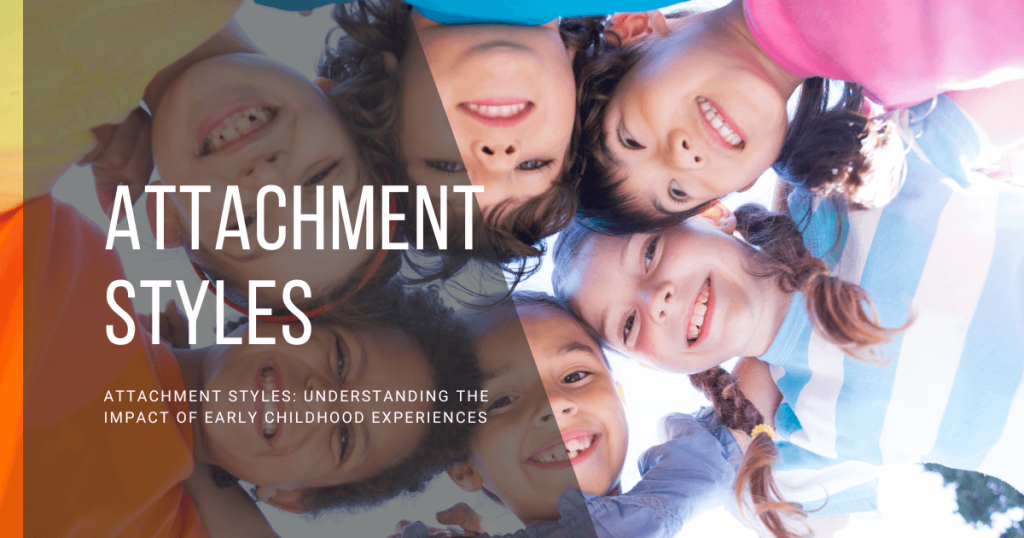As humans, our need for connection and attachment begins at birth. The bonds we form with our primary caregivers in early childhood play a crucial role in shaping our emotional development and how we perceive relationships throughout our lives.
In this blog, we will delve into the world of attachment styles – a concept coined by psychologist Mary Ainsworth in the 1970s – and explore how different attachment styles are formed, how they manifest in childhood and adulthood, and their impact on our relationships with others.
What is ‘Attachment Style’?
An attachment style is the way we relate and connect with others based on our early experiences with our primary caregivers. These styles, which develop by around age five, greatly influence our future relationships and emotions.
There are four main attachment styles:
– Secure
– Anxious
– Avoidant
– Disorganized
Every style represents how we perceive and respond to intimacy, closeness, and vulnerability in relationships. Knowing our attachment style gives us valuable insights into our strengths, challenges, and relationship needs, making it easier for us to build healthier and more satisfying connections.
The Four Attachment Styles
Now, let’s dig deeper into the four main attachment styles.
For each style, we’ll explore what it means and how it typically develops during early years based on a child’s interaction with their caregivers. We’ll also examine how it impacts and shows up in our adult lives.
By looking into these styles, we can gain a clearer understanding of why we react the way we do in our relationships and how our early experiences shape our emotional responses.
So, get ready to uncover the significant influence of our earliest relationships on our adult lives.
Secure Attachment
Secure attachment is the healthiest form of attachment which is characterized by a positive view of oneself and others.
This attachment style typically develops in early childhood when a child has a caregiver who is consistently responsive, empathetic, and supportive. Caregivers of securely attached children tend to meet their child’s needs promptly and effectively, providing a safe environment where the child feels loved and understood.
They also encourage the child’s independence, supporting their exploration of the world around them while being available as a secure base to return to when needed. Consequently, these children learn to associate relationships with security, comfort, and trust, forming a positive perspective toward themselves and others in their relationships.
How Does This Show Up In Adulthood?
In adulthood, a securely attached individual tends to maintain healthy, long-term relationships. They have a strong sense of self-esteem and are comfortable with intimacy and interdependence, striking a balance between their need for intimacy and their desire for independence.
In relationships, they are not afraid to express their feelings or needs and are receptive to their partners doing the same. They prioritize open communication and mutual respect, fostering a sense of trust and safety with their partners.
Outside of relationships, securely attached adults:
– Have strong coping mechanisms
– Handle rejection and loss well
– Remain resilient in the face of adversity
– Have a positive outlook on life
– Are confident in their abilities
– Are generally content with who they are.
They are also likely to have a diverse and supportive social network, maintaining deep, meaningful friendships. They embrace new experiences with optimism and are comfortable navigating changes and challenges, reflecting the secure base provided by their caregivers in their early years.
How To Relate To a Secure Attachment Style:
As teachers or adults, relating to someone with a secure attachment style is often much simpler than dealing with a child or student with any of the other three attachment styles.
This is primarily because securely attached individuals are generally confident, open to communication, and can establish and maintain healthy boundaries. They are responsive to positive reinforcement and are more likely to openly discuss any challenges they might be facing.
When they do experience difficulties, reassure them of their abilities and assist in developing coping strategies, while also giving them space to solve problems on their own. This balance of autonomy and support reflects the secure base provided in their early years.
In an educational context, create an environment that encourages curiosity, exploration, and positive social interactions, reinforcing their positive perspective of themselves and the world around them.
Anxious Attachment:
Anxious Attachment is characterized by a strong desire for closeness and intimacy, alongside a fear of rejection and abandonment.
Children develop an anxious attachment style due to inconsistent caregiving in their early years. This inconsistency can arise when caregivers are sometimes responsive and attentive to the child’s needs, but at other times, they may be unavailable or dismissive.
This unpredictable pattern of care can leave the child feeling insecure and unsure, leading to anxiety. They learn not to trust the availability of their caregiver, and as a result, they develop a need to seek constant reassurance and validation in their relationships.
How Does This Show Up In Adulthood?
As adults, people with an anxious attachment style are often more sensitive to their partner’s behaviors. They may mistakenly interpret their actions as signs of rejection or abandonment, which can create a cycle of perceived threats to their relationship.
They might also show clingy behavior, always needing reassurance, and being emotionally reactive, which can cause frequent arguments or emotional turmoil. Because they fear being alone, they might stay in unhealthy relationships and tolerate unacceptable behavior because they’re terrified of being abandoned.
Outside relationships, these individuals often:
– Struggle with self-esteem issues
– Frequently seek validation from others
– Tend to be self-critical
– Are overly concerned with others’ opinions
– Have a negative self-image.
In social situations, they may come across as overly dependent or needy.
They may also experience issues with setting boundaries, continually prioritizing others’ needs over their own. Their work and personal life can be affected as they struggle with constant worry and anxiety, particularly around interpersonal relationships.
How To Relate To an Anxious Attachment Style:
Relating to individuals with an anxious attachment style requires understanding and patience. As a teacher or adult, it’s crucial to provide consistent and reliable support.
This can be achieved by:
– Openly communicating
– Setting clear expectations
– Maintaining a predictable routine
– Frequent positive reinforcement (to help alleviate their fears and insecurities)
– Praising their achievements and strengths (to foster a positive self-image and boost their self-esteem)
– Encouraging them to express their feelings, and reassure them that it’s okay to have needs and set boundaries
In the classroom, create an inclusive and safe environment that promotes trust and open communication. Encourage peer interaction to develop their social skills and build healthy relationships.
Lastly, remember that progress takes time. Patience and understanding are key in helping individuals with an anxious attachment style navigate their emotions and build healthier relationships.
Avoidant Attachment:
An avoidant attachment style usually happens when a caregiver is emotionally unresponsive, dismissive, or overly critical in their interactions with the child.
Additionally, the development of an avoidant attachment style is often linked to a caregiver consistently neglecting the child’s emotional needs. This can look like ignoring the child when they’re upset or disregarding their feelings as unimportant.
As time goes on, the child learns that their emotions aren’t valid or deserving of attention, causing them to suppress their feelings. They may also learn to avoid relying on others for support because it has led to disappointment or rejection in the past.
Caregivers may have also placed too much importance on the child being independent and self-reliant. This could have included pushing the child to do things on their own before they were ready or punishing them for asking for help. This early emphasis on independence can result in the child developing a pattern of avoiding seeking support because they associate it with negative consequences.
How Does This Show Up In Adulthood?
As adults, people with avoidant attachment styles tend to value independence and self-reliance. Trusting others and forming close relationships can be challenging for them. They often avoid emotional closeness and intimacy, which they may perceive as demanding or intrusive.
These individuals may appear distant in relationships, preferring to keep their emotions to themselves. They may also downplay the significance of close relationships and steer clear of responsibilities that involve others, like taking on a leadership role at work.
How To Relate To an Avoidant Attachment Style:
When dealing with individuals who have an avoidant attachment style, it’s crucial to respect their comfort zone while gradually showing them the benefits of emotional closeness. Patience and understanding are key, as they may take longer to trust and open up.
Try to communicate your intentions clearly, avoiding any hint of pressure or intrusion into their personal space. Encourage open dialogue and gently express your feelings, without overburdening them with emotional demands.
Remember, the goal is not to change them, but to create an environment where they feel safe to explore their emotions.
In a classroom setting, it’s beneficial to provide clear instructions, ensure the individual has the resources to work independently, yet provide consistent reassurance that you are there to support them when needed. This balance can help them slowly gain confidence in their ability to form secure and healthy relationships.
Disorganized Attachment:
When caregivers are inconsistent or erratic in their behavior, it can lead to the development of a disorganized attachment style in children. These caregivers may have been loving and responsive at times, but neglectful or abusive at others.
This creates a paradox for the child, as they instinctively seek comfort from the same person who causes them distress.
This confusion can cause the child to show different behaviors to get what they need. That’s why the attachment style is disorganized. They don’t consistently avoid or seek closeness with the caregiver, which leads to an unpredictable behavior pattern.
How Does This Show Up In Adulthood?
In adulthood, individuals with a disorganized attachment style may exhibit a confusing mix of behaviors, seeking closeness and intimacy one moment and then pushing their partners away the next. This can make relationships challenging, as their partners may struggle to understand their needs and responses.
Outside of relationships, these individuals might have a hard time handling stress and could act on impulses or in unpredictable ways. They might struggle to control themselves and could encounter various mental health problems, such as depression, anxiety, or post-traumatic stress disorder.
Their interactions with others might be marked by a lack of trust and fear of being abandoned, which can make it difficult to establish stable and rewarding relationships in both personal and professional settings.
How To Relate To a Disorganized Attachment Style:
Relating to individuals with a disorganized attachment style requires patience, understanding, and consistency. As teachers or adults interacting with these individuals, the aim is to establish a sense of safety and predictability.
Consistent responses and clear communication are key. Avoid reacting harshly to their erratic behaviors; instead, display patience and an open line of communication. Offering reassurance and affirming their feelings can help build trust.
In an educational setting, teachers can create a secure, structured environment to support students with disorganized attachment by:
– Regular routines
– Predictability in the classroom
– Clearly defined rules
– Encouraging students to express their emotions verbally rather than acting out
– Providing a safe space for them to do so
Professional development in understanding attachment styles and their impact on behavior and learning can also be beneficial. Remember, these behaviors are not personal or a reflection of your teaching abilities; they are defensive mechanisms formed in response to early experiences. With understanding, patience, and consistent support, these individuals can begin to form healthier relationships and manage their behaviors more effectively.
Is It Possible To Change My Attachment Style?
Absolutely, it is possible to change your attachment style. It requires dedication, effort, and often professional guidance, but rest assured, a more secure and healthy attachment style is within your reach.
One of the first steps is self-awareness. Understanding your attachment style and recognizing the patterns in your relationships can help you identify areas of insecurity.
Therapy or counseling can significantly assist you in this journey. A trained professional can provide insights into your behaviors and emotional responses, helping you understand your attachment style better and guiding you toward healthier patterns.
Mindfulness, a practice of being present and acknowledging your feelings and thoughts without judgment, can also be beneficial. It can help you to react less impulsively to emotional triggers and to respond in a more balanced and thoughtful way.
Lastly, secure relationships can be a powerful force for change. Establishing connections with individuals who have secure attachment styles can provide you with positive relationship models. With time, these relationships can help reinforce healthy attachment behaviors, leading to a more secure attachment style. Remember, change takes time and patience, but with commitment, a healthier, more fulfilling way of relating to others is achievable.
Contact Reggie today to learn more about attachment styles.







